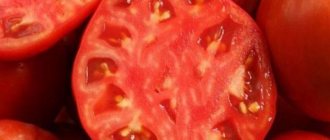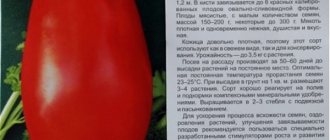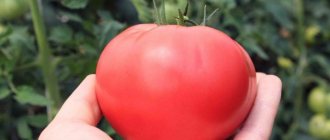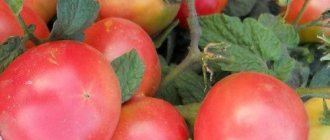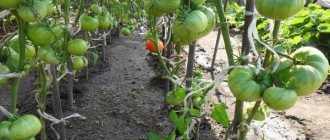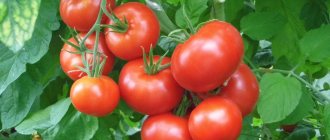Tomato "Swamp" - an original variety of green tomatoes
In recent years, gardeners are increasingly growing vegetables of unusual colors on their plots, including tomatoes. Summer residents have already become accustomed to the bright orange and lemon-yellow fruits of tomatoes, but the unusual color of ripe Swamp tomatoes still looks unusual in summer garden beds. The variety got its name for the swampy color of the fruits, which when ripe may have inclusions of red color, but their main tone is greenish-swampy. Other positive qualities of the variety will be discussed below.
The content of the article:
1. History of creation 2. Tomato “Swamp” description of the variety 3. Yield indicators of the tomato Swamp 4. Advantages and disadvantages 5. Nuances of growing and caring for the tomato Swamp 6. Reviews about the tomato variety “Swamp” 7. Information from the manufacturer
Photo of tomato Swamp
Features of cultivation and storage
Agricultural technology for tomatoes Swamp is not difficult. Gardeners recommend adhering to a number of rules and preparing planting material in advance.
- Preparing seedlings. Seeds are planted for seedlings in early March. The variety can also be planted at an earlier date.
- Light, nutritious soils are chosen for seeding material. Before sowing, the seeds are soaked in antiseptic solutions.
- Temperature conditions and care of seedlings. For seedling containers, maintain a temperature range of 22-25 degrees. Before the first shoots appear, watering is practically not carried out. After the sprouts appear, the containers are transferred to a bright place. Seedlings are watered as needed.
- Picking. To strengthen the root system at the stage of 2-3 leaves, picking is carried out.
- Transfer to the ground. The seedlings are transferred to the ground at the end of May. The variety shows the best results when grown in closed greenhouses
- The soil. Light soils with neutral acidity are considered optimal for Swamp tomatoes.
- Watering. Tomatoes are moisture-loving. Watering is carried out daily, but make sure that the water does not stagnate on the ridges. Bog is one of the few tomato varieties that bear fruit well in rainy summer conditions. They even tolerate marshy soil.
- Feeding. Fertilizers are applied several times per season. Use universal mineral compositions.
- Pest control. The variety is not resistant to diseases and pests. For this reason, plants are regularly inspected and treated with disinfectants.
Further care includes:
- Periodic watering with warm water (in the evening);
- Weed removal;
- Loosening the soil;
- Two or three fertilizing with mineral fertilizers.
Like other tomatoes, Bolot is grown in seedlings. Seeds are sown 50-55 days before planting the plants in a permanent place. The optimal time for sowing is considered to be the beginning or middle of March.
Before sowing seeds, familiarize yourself with the indicators of the lunar calendar. Seeds planted on a suitable lunar day will germinate faster and the plants will be healthier.
The Swamp variety is not resistant to plant diseases. Therefore, you need to take the preparation of seeds especially seriously:
- Check the expiration dates of planting material. Remove all black, moldy and damaged seeds.
- To test seeds for germination, soak them for half an hour in a saline solution. Remove those that float, and rinse and dry those that sink to the bottom.
- Disinfect the seeds. To do this, immerse them for 20 minutes in a solution of potassium permanganate, diluted in a ratio of 1:100.
To increase the germination rate, seeds are stimulated. The most popular methods:
- Purchased funds. The stores offer a lot of drugs that stimulate seed germination (Kornevin, Zircon, Novosil, etc.). They are used according to the instructions for use.
- Folk remedies: soda and honey solution, aloe juice. They impregnate the fabric in which the seeds are wrapped. Then the damp cloth with planting material is placed on a saucer and covered with film.
- Stimulation with cold. The seeds are placed in the refrigerator for several days, then transferred to a warm place. After this, you can start sowing.
To sow seeds, use large containers that can hold a large amount of planting material: trays, special boxes.
Plant the plants in a small container. To pick tomatoes, use special pots, disposable cups and any other containers.
For tomatoes choose light soil. This can be a special soil mixture or a self-prepared composition, for which equal portions of peat, humus and turf are taken. A matchbox of superphosphate and a little ash are added to the mixture.
Both containers and soil for tomato seedlings need to be disinfected - pour boiling water or a solution of potassium permanganate over them.
Soil is poured into the prepared containers. Grooves 1 cm deep are made in it. The distance between the grooves is 2-3 cm. Seeds are placed in the grooves at intervals of at least 2 cm. The planting material is covered with earth on top.
After planting the seeds, moisten the soil with a spray bottle. The container is covered with glass on top and placed in a place with a temperature of at least 23 degrees.
Caring for seedlings requires minimal labor. The main thing is to follow the basic rules for caring for tomatoes at this stage:
- Watering plants. No watering is needed before germination. After the first shoots appear, the soil is moistened with a syringe or pipette as it dries. The planted tomatoes begin to be watered a week after picking with settled water so that the liquid gets only onto the soil.
- Picking. After 3 true leaves appear, the tomatoes are planted in separate containers. Do this carefully so as not to damage the root.
- Feeding. Tomatoes, planted in separate containers, are fertilized for the first time two weeks after transplantation. For these purposes, complex fertilizers are used. Then two more feedings are made - after 14 days and a few days before transplanting to a permanent place.
- Hardening. Plants begin to harden off two weeks before planting seedlings in the ground. To do this, tomatoes are taken outside every day, gradually increasing the time.
When grown in open ground, the plant reaches a height of 110-120 cm. In a greenhouse, the bushes grow slightly higher - 150 cm. Take this into account when choosing the size of the support pegs and the greenhouse structures themselves.
Tomatoes need fresh air. Therefore, regularly ventilate the greenhouse by opening the windows.
When transplanting seedlings into open ground, the tomatoes are covered with film for the first week. This protects them from night frosts.
In open ground, Swamp tomatoes must be mulched. The beds are covered with straw, hay or burlap.
To get a decent harvest, it is not recommended to plant tomatoes in the place where tomatoes, potatoes or eggplants used to grow. The best predecessors are carrots, cauliflower, cucumbers, dill or parsley. They saturate the soil with organic substances suitable for tomatoes.
Productivity directly depends on the correct implementation of planting and plant care measures:
- timely watering;
- fertilizing with mineral and organic fertilizers;
- mulching and loosening the soil;
- pinching shoots;
- garter to the fixing support if necessary.
Tomatoes are grown in seedlings. In early March, the seeds are sown to a depth of 1-1.5 cm. Regularly watered and fertilized throughout the entire growth period.
It is a good idea to prepare the seeds before planting. To do this, they are placed in water for 10-15 minutes and those that float to the surface are selected - they are suitable for landing, the rest can be disposed of. To disinfect the seeds, they are placed in a 2% solution of potassium permanganate for 15-20 minutes.
Early maturing / Medium growing
User rating: 4/5
Mid-season / Mid-season
User rating: 5/5
Mid-season / Mid-season
For planting, select a well-lit area. It’s better if cauliflower, carrots, and cucumbers grew on it before.
Prepare the site in the fall. Use 4 kg of humus, scattering it over 1 m2 of land, and then dig it up. Remove all weeds. And in early spring, sprinkle 1 m2 of soil with 80 g of superphosphate and 20 g of potassium chloride, dig it again.
Plant seedlings on a cool, cloudy but windless day. When planting, bury the stems 2 cm into the ground, then additional roots will grow. Immediately prepare supports and tie up bushes. You can use trellises. After planting, water the tomatoes with warm water.
When planting seedlings, it is better to form a bush into 2 stems, tie them up, and cut off the stepsons in a timely manner.
Constantly water the bushes with warm water every 3-4 days; after watering, be sure to loosen the soil so that a crust does not form on it, and pull out the weeds. Feed with nitroammophoska 2-3 times during the season. Before fertilizing, water the bushes generously, and after fertilizing, water again.
Instead of nitroammofoska, you can make this fertilizer by feeding the tomatoes 2 weeks after planting the seedlings on the site: pour part of the chicken manure into a bucket and pour in 15 parts of water, then add 300 g of ash and 50 g of superphosphate. Mix everything well. A bucket of such fertilizer is enough for 15-20 bushes.
Trim off the lower leaves when the bushes are large enough.
If you spray the bushes with Epin-Extra, the tomatoes will set better and a larger crop will grow. To prevent fungal diseases, you can spray the plants with compounds that contain copper or sulfur.
Tomato seeds are sown in the house for seedlings from February 20 to March 10.
Check the seeds before planting. Pour a spoonful of salt into a glass of water and place the seeds in the glass for 15 minutes. Bad seeds will float, and good ones will be at the bottom. Rinse them and dry them. Next, place the seeds in a damp cloth and wait 24 hours.
It is better to sow 3-5 seeds to a depth of 1 cm in one plastic cup, then the seedlings will not need to be picked. Moisten the soil thoroughly after planting.
When each bush has 6-8 leaves and is 25 cm high, it can be planted in an open area. In the Central region of Russia this is done at the end of May.
Thus, the Swamp tomato is distinguished by unusual greenish fruits that can be placed in salads.
History of creation
This variety was bred by breeders from Russia several years ago, almost immediately it was included in the State Register of our country and recommended for cultivation under film covers in different regions of Russia. In the south, you can plant the Swamp tomato directly in open ground.
Despite the fact that the variety is quite new, many summer residents have already grown it in their gardens. Reviews about the Swamp tomato variety are very different, but not everyone likes the fact that this tomato is quite capricious, requires additional care, and cannot tolerate low temperatures. But most vegetable growers note the exotic nature of ripe fruits, which adds variety to their garden beds.
Pest and disease control
To prevent late blight and other fungal diseases, immediately after transplanting Swamp tomatoes into open ground or a greenhouse, summer residents treat the bushes with a fungicide (one to choose from):
- "Fitolavin";
- "Ordan";
- "Farmayod";
- "Profit";
- Bordeaux mixture.
If pests appear on the bushes, they can be dealt with using folk remedies, for example, a solution of wood ash, an infusion of onion peels, chopped garlic, and dry mustard powder. If they do not give the desired result, it is recommended to use insecticides:
- "Aktara";
- "Biotlin";
- "Decis";
- "Fufanon";
- "Confidor"
Important! When growing Swamp tomatoes in open ground, treatment is carried out in dry and windless weather. Harvesting can begin no earlier than in 5-10 days.
Tomato “Swamp” description and characteristics of the variety
In terms of ripening time, the Boloto tomato is an early ripening variety - just over 3 months pass from the moment the sprouts appear to the harvest. When grown in beds in open ground, the height of the shoots can reach 1-1.1 m; in greenhouse conditions, the bushes grow up to 1.40-1.45 m. The shoots are medium leafy, erect, strong.
This variety belongs to the indeterminate type of tomatoes, the foliage is medium in size, rich emerald color. To the touch the foliage is slightly loose and slightly corrugated.
Important!
According to the description, these tomatoes are used for fresh consumption and in salads. However, according to reviews from many housewives, the ripe fruits of the Boloto tomato can be used for pickling and whole-fruit pickling.
When growing a Swamp tomato, each bush should be formed into two shoots. Mandatory gartering of stems and periodic removal of stepsons is also necessary. Experts recommend cutting off foliage that grows below the first formed cluster with ovaries.
The best varieties of tomatoes!
• Yellow tomatoes BANANA LEGS • Large HEAVYWEIGHTER of Siberia • Early ripening tomatoes RED GUARD
The shape of the ripening fruit is flat-round, with clearly visible ribbing.
In open ground, ripe tomatoes weigh 160-210 g, and in greenhouses you can harvest fruits weighing up to 300 g. The color of unripe fruits is rich green; as the tomatoes ripen, splashes of yellow and pink appear on them.
The stalk of a ripe tomato has a clearly visible spot of dark emerald color.
Productivity of tomato "Swamp"
Up to 3 bushes of this variety are planted per 1 m2; the yield from these tomatoes in open ground is up to 5.5 kg, in greenhouse conditions - up to 6 kg.
The presentation of ripe fruits is interesting and unique, but the crop does not tolerate transportation even over short distances and is poorly stored in any conditions.
The taste of ripe tomatoes is not bad, the aroma is typically tomato.
Resistance to most diseases affecting vegetable plants of the nightshade family is average.
Characteristics
The country where the variety was bred is Russia. The fruits have a flat-round shape, well-defined ribbing. The average weight is 150-220 grams; when grown in a greenhouse, fruits weighing 280-310 grams are noted. Unripe fruits are green, ripened green with pink or yellow splashes, a well-defined dark green spot at the stalk.
| Variety name | Fruit weight |
| Swamp | 150-310 grams |
| Tarasenko Yubileiny | 80-100 grams |
| Rio Grande | 100-115 grams |
| Honey | 350-500 grams |
| Orange Russian 117 | 280 grams |
| Tamara | 300-600 grams |
| Wild Rose | 300-350 grams |
| Honey King | 300-450 grams |
| Apple Spas | 130-150 grams |
| Thick cheeks | 160-210 grams |
| Honey Drop | 10-30 grams |
Productivity is 4.8-5.5 kilograms in open ground, in a greenhouse 5.4-6.0 kilograms when planting no more than 3 bushes per square meter of land. Fresh tomatoes have good presentation, do not tolerate transportation well, low performance during long-term storage.
| Variety name | Productivity |
| Swamp | 5-6 kg per square meter |
| Marissa | 20-24 kg per square meter |
| Sugar cream1 | 8 kg per square meter |
| Buddy f1 | 8-10 kg per square meter |
| Siberian early ripening | 6-7 kg per square meter |
| Golden stream | 8-10 kg per square meter |
| Pride of Siberia | 23-25 kg per square meter |
| Liana | 2-3 kg per bush |
| The Lazy Man's Miracle | 8 kg per square meter |
| President 2 | 5 kg per bush |
| Leopold | 3-4 kg per bush |
Excellent taste in salads; tomatoes have performed well when canned with whole fruits.
Advantages:
- exotic appearance;
- excellent, sweetish taste;
- versatility of fruit use;
- early ripening.
Flaws:
- the need for tying and pinching bushes;
- poor preservation, friability of fruits.
Tomato variety "Swamp": advantages and disadvantages
Positive and negative qualities of the variety in comparison with other varieties
The undoubted advantages of the variety include:
- unusual appearance of ripe fruits;
- excellent taste - slightly sweet and slightly sour fruits will add originality to any salad;
- the fruits are universal - can be used fresh, as well as for canning;
- early ripening variety.
Photo of tomatoes Swamp on a bush
But the Swamp tomato also has a number of disadvantages:
- mandatory formation of bushes;
- the need to garter shoots and remove stepsons;
- poor resistance to anthracnose;
- The harvested crop does not tolerate transportation well and is not stored for long.
Video
Tomato ordinary Swamp. Brief overview, description of characteristics, where to buy seedlings, seeds
The best varieties of tomatoes without pinching for open ground in central Russia!
TOMATO FROG QUEEN – A GREEN MIRACLE FOR EVERYONE. Olga Chernova.
Tomato variety "Swamp"
I HAVE BEEN PLANTING ONLY THIS VARIETY OF TOMATOES FOR 65 YEARS!
I still collect these tomatoes! The best tomato varieties and hybrids of the 2020 season
TOMATO Swamp. The most delicious tomato
The best early ripening varieties of tomatoes Descriptions and characteristics of early tomatoes
The best varieties of meaty tomatoes. 5 varieties of large-fruited tomatoes. Tomatoes 2021 Siberian selection.
Tomato Green sweet * Varieties of tomatoes
Review of the most popular varieties of tomatoes grown here!
Tomato Swamp og (tasting section) 2020
LONG-PLAYING TOMATO VARIETIES. What are they? Description 4 varieties
Tomato Swamp. Tasting. How to cut leeks for salad.
Yield varieties of TOMATOES: in seeds and in reality
Tomato Mongolian Dwarf: the productivity of this variety is legendary!
Standard yield tomatoes (best varieties of tomatoes)
Agronomist's review: Parrot and Swamp are delicious tomatoes!
Tomato Swamp: growing and caring for the variety
When growing a tomato of this variety, one should not forget about the rules of crop rotation; the best predecessors for the Boloto tomato are cucumbers, cauliflower or carrots.
In most regions of our country, it is better to first grow seedlings at home, which are then transplanted into beds in the vegetable garden under film or in greenhouses. And only in the southern regions do vegetable growers plant Boloto tomato seeds directly into open ground.
The best tomato varieties!
• Early tomato RED GUARD • SCARLET MUSTANG • Fruitful VISIBLE AND INVISIBLE • VALENTINE
Caring for these tomatoes consists of regular watering with heated water at sunset, removing weeds, periodic fertilizing and loosening the soil.
It is also advisable to treat seedlings and adult tomato plants Swamp for preventive purposes against possible diseases and attacks by insect pests. Vegetable growers can increase the yield of the variety if they spray tomato bushes with Epin-extra solution several times a season.
Diseases and pests
The variety is not resistant to diseases and pests. The plant can be attacked by late blight and blossom end rot. Anthracnose greatly compromises the health of roots and fruits. The disease manifests itself as follows: the skin of tomatoes becomes soft, turns brown, and turns black over time. As a result, the fruit dries up.
Most often, “swamp” tomatoes are bothered by the same pests as other varieties: fall armyworm, Colorado potato beetle, aphids, whiteflies, wireworms. The variety's favorite high humidity is especially conducive to the development of diseases and the appearance of pests.
To prevent diseases and harmful insects, the following measures are used:
- seeds are treated with immunocytophytes before sowing;
- the bushes are periodically sprayed with Quadrix or Flint;
- Tomatoes are treated with solutions of sulfur and copper.
At least twice during the growing season, tomatoes should be sprayed with complex agents against diseases and pests.
Tomato "Swamp": reviews and photos of those who planted
Reviews from those who grew Boloto tomatoes:
Elena, Ryazan:
I grow Boloto tomatoes in my greenhouse. The variety is really early ripening, but I first grow seedlings at home. I also treat seedlings and adult plants several times for preventive purposes against diseases, since the resistance of the variety to them is indicated as average. Maybe that’s why the bushes of this tomato don’t get sick in my greenhouse.
Large-fruited varieties of tomatoes!
• GIANT raspberry • tomatoes HEAVYWEIGHTER of Siberia
Natalya, Krasnodar region:
In our climate I grow the Swamp tomato in the beds in the garden. I plant the seeds directly in the ground in early May under a film. When the seedlings grow up and the likelihood of return spring frosts is already negligible, I remove the film. This usually happens by the end of the second ten days of May. We use the harvested crops to make salads. I also partially preserve whole fruits.
Svetlana, Volgograd:
In our region, I grow these tomatoes in open ground. True, I first plant the seeds of the Swamp variety at home for seedlings, and when the plants grow up, I transplant them into prepared beds. The yield of the variety is pleasing, although you have to tie it up, trim it, and shape the bushes, but in general. These plants do not cause much trouble.
It is recommended to grow this heat-loving variety in most regions of Russia in greenhouses, film tunnels or greenhouses. With proper care, summer residents receive good harvests. The only drawback is that the harvested crop does not have a very high shelf life, so it has to be processed in a fairly short time.
Description of the tomato variety
Fruit:
- Large size fruits;
- Average weight is from 150 to 200 grams. Some specimens reach 300 grams or more;
- They have a rounded-flattened shape;
- When fully ripe, yellow-brown in color;
- The flesh is bright emerald green interspersed with pinkish color.
Bushes:
- Plant of indeterminate type;
- In open ground, bushes grow 100-110 cm, in closed ground - 150 cm;
- The green leaves are large in size, loose to the touch, slightly corrugated.





